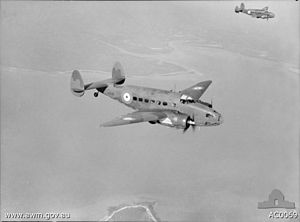No. 13 Squadron RAAF
| No. 13 Squadron RAAF | |
|---|---|

Two Hudson aircraft from No. 13 Squadron near Darwin in 1940
|
|
| Active | 1 June 1940 – 11 January 1946 1 July 1989 – current |
| Branch | Royal Australian Air Force |
| Role | Base operations and training |
| Part of | Combat Support Group |
| Garrison/HQ | RAAF Base Darwin |
| Motto(s) | "Resilient and Ready" |
| Commanders | |
| Notable commanders |
John Balmer (1940–41) |
No. 13 (City of Darwin) Squadron is a Royal Australian Air Force (RAAF) squadron. The squadron saw combat during World War II as a bomber and maritime patrol squadron and is currently active as a mixed regular and reserve RAAF unit located in Darwin, fulfilling both operational support and training duties.
No. 13 Squadron was formed from elements of No. 12 Squadron at RAAF Base Darwin on 1 June 1940. Its first commanding officer was Wing Commander John Balmer. The squadron initially operated Avro Ansons, serving in the general reconnaissance role and flew maritime surveillance patrols over the seas to the north of Australia and survey flights over northern Australia. The squadron was re-equipped with Lockheed Hudson light bombers, suffering its first loss in September when one aircraft was destroyed on take-off. In early 1941, the squadron was tasked with locating a German commerce raider and a U-boat, before joining the search for survivors from HMAS Sydney following its battle with the German auxiliary cruiser Kormoran. In May 1941, the squadron began flying familiarisation flights over the Netherlands East Indies in preparation to deploy to the NEI following the outbreak of war with Japan.
On 7 December, following the start of the Pacific War, No. 13 Squadron deployed two flights of Hudson light bombers to Ambon, where they were based at Laha Airfield. Three days later, the squadron's commander, Wing Commander Joshua McDonald, was killed in an accident; Squadron Leader John Ryland took over and shortly afterwards the squadron deployed a third flight to Namlea Airfield on Buru Island. At the end of the month, the third flight moved to Babo in Dutch New Guinea. Flying in the face of heavy resistance, and lacking fighter support, the squadron's aircraft conducted operations throughout the eastern islands of the NEI, during which several aircraft were lost. Others were also destroyed on the ground as Japanese aircraft attacked Laha. The surviving aircraft from these flights returned to Darwin in February 1942, as Ambon faced invasion.
...
Wikipedia
